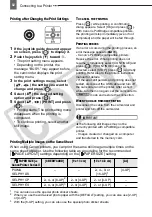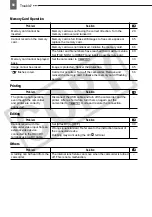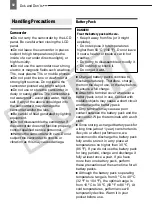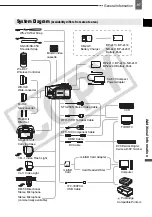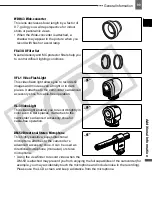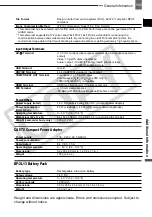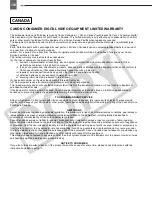
94
Do’s and Don’ts
the slot if it is not correctly oriented may
damage the memory card or the
camcorder.
Do not attach any labels or stickers on
the memory card.
When you erase image files or initialize
the memory card, only the file allocation
table is altered and the data itself is not
actually deleted. Take the necessary
precautions when you dispose of the
memory card, for example by physically
damaging it to prevent the leakage of
private data.
Lithium Button Battery
Do not pick up the battery using
tweezers or other metal tools as this will
cause a short circuit.
Wipe the battery with a clean dry cloth
to ensure proper contact.
Keep the battery out of the reach of
children. If swallowed, seek medical
assistance immediately. The battery case
may break and the battery fluids may
cause internal damage.
Do not disassemble, heat or immerse
the battery in water to avoid the risk of
explosion.
For California, USA only:
The lithium
battery included contains Perchlorate
Material – special handling may apply.
See www.dtsc.ca.gov/hazardouswaste/
perchlorate for details.
Built-in Rechargeable Lithium Battery
The camcorder has a built-in
rechargeable lithium battery to keep the
date/time and other settings. The built-in
lithium battery is recharged while you use
the camcorder, however, it will become
totally discharged if you do not use the
camcorder for about 3 months.
To recharge the built-in lithium battery:
Connect the compact power adapter to
the camcorder and leave it connected for
24 hours with the
switch set to
.
WARNING!
• The battery used in this device may
present a fire or chemical burn hazard if
mishandled. Do not recharge,
disassemble, heat above 100 °C (212 °F)
or incinerate the battery.
• Replace the battery with a CR2025 made
by Panasonic, Hitachi Maxell, Sony,
Sanyo, or with Duracell2025. Use of
other batteries may present a risk of fire
or explosion.
• Dispose of the used battery according to
applicable recycling regulations.
CO
PY



